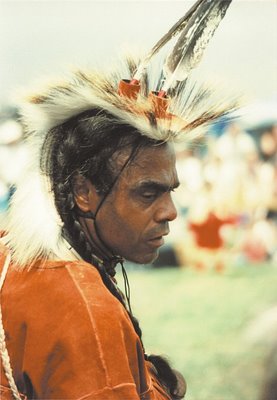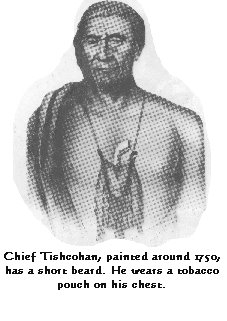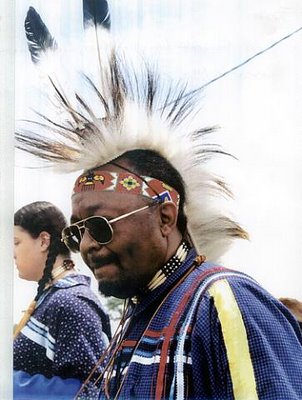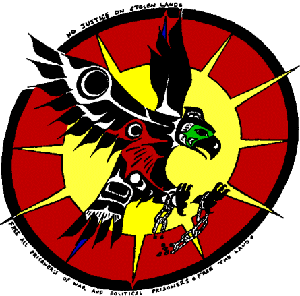


11429404204209401142
Lenape
From Wikipedia, the free encyclopedia
Jump to: navigation, search
Lenape
Total population Only 2 pure Lenapes left (As of 1999)
Significant populations in United States (Oklahoma, Kansas, Wisconsin, New Jersey)
Canada (Ontario)
Language English, Delaware
Religion Christianity, other
Related ethnic groups other Algonquian peoples
The Lenape or Lenni-Lenape (later named Delaware Indians by Europeans) were, in the 1600s, loosely organized bands of Native American people practicing small-scale agriculture to augment a largely mobile hunter-gatherer society in the region around the Delaware River, the lower Hudson River, and western Long Island Sound. The Lenape are the people living in the vicinity of New York Bay and in the Delaware Valley at the time of the arrival of the Europeans in the 16th and 17th century. Their Algonquian language is also known as Lenape or Delaware.
Contents
* 1 History
o 1.1 Early Lenape society
o 1.2 Colonial times
o 1.3 The nineteenth century
* 2 Lenape nations today
* 3 Notable Lenape Indians
* 4 References to the Lenape in literature
History
Early Lenape society
Although a different order may have prevailed earlier, in Colonial times Lenape families (like many other Indian peoples) were (are) organized into clans based on a common female ancestor. Phratries, which were groups of two or more clans, were (are) identified by an animal sign. Three Lenape phratries emerge in the early historical record: Turtle (Unami), Turkey (Ungalachtigo), and Wolf (Munsi). These phratries are not political divisions, but rather 'flavors' of individuals common to all discrete bands of Lenape, which together make up the Lenape 'tribe' -- although the very notion of 'tribe' is misleading, suggesting a uniformity that does not exist.
Early Indian 'tribes' are perhaps better understood as language groups, rather than as 'nations.' A Lenape individual has identified primarily with his or her immediate family and friends, or village unit; then with surrounding and familiar village units; next with more distant neighbors who speak the same dialect; and ultimately, while often fitfully, with all those in the surrounding area who speak mutually comprehensible languages, including the Mohican. Those of a different language stock -- such as the Iroquois (or, in the Lenape language, the Minqua) -- were regarded as foreigners, often, as in the Iroquois' case, with animosity spanning many generations. (Interestingly, ethnicity itself seems to have mattered little to the Lenape and many other 'tribes,' as illustrated by archaeological discoveries of Munsee burials that included identifiably ethnic-Iroquois remains carefully interred along with the ethnic-Algonquian Munsee ones. The two groups were bitter enemies since before recorded history, although intermarriage, perhaps through captive-taking, clearly occurred).
Overlaying these relationships is that of the phratry. Phratry membership is matrilineal; that is, a child inherits membership in a phratry from his or her mother. On reaching adulthood, a Lenape traditionally marries outside of his or her phratry, a practice known by ethnographers as "exogamy", which effectively serves to prevent inbreeding even among individuals whose kinship was obscure or unknown.
Early Europeans who first wrote about Indians found this type of social organization to be unfamiliar and perplexing. As a result, Europeans often try to interpret Lenape society through more familiar European arrangements. As a result, their early records are full of clues about early Lenape society, but were usually written by observers who did not fully understand what they were seeing. For example, a man's closest male ancestor was usually considered to be his uncle (his mother's brother) and not his father, since his father belonged to a different phratry. Such a concept is often unfathomable to early European chroniclers.
Land is assigned to a particular clan for hunting, fishing, and cultivation. Individual private ownership of land was unknown, but rather the land belongs to the clan collectively while they inhabit it(see New Amsterdam for discussion of the Dutch "purchase" of Manhattan). Phratries live in fixed settlements, using the surrounding areas for communal hunting and planting until the land is exhausted, at which point the group moved on to found a new settlement.
Colonial times
The early interaction between the Lenape and the Dutch was primarily through the fur trade, specifically the exchange of beaver pelts by the Lenape for European-made goods.
According to Dutch settler Isaac de Rasieres, who observed the Lenape in 1628, the Lenape's primary crop is maize (corn), which they plant in March after breaking up the soil using metal tools traded by the Europeans. In May, the Lenape plant kidney beans in the vicinity of the maize (corn) plants to serve as props. The summers are devoted to field work and the crops are harvested in August. Most of the field work is carried out by women, with the agricultural work of men limited to clearing the field and breaking the soil.
Hunting is the primary activity in the rest of the year. Dutch conqueror/settler David de Vries, who stayed in the area from 1634 to 1644, described a Lenape hunt in the valley of the Achinigeu-hach (or "Ackingsah-sack," the Hackensack River), in which 100 or more men stood in a line many paces from each other, beating thigh bones on their palms to drive animals to the river, where they could be easily killed. Other methods of hunting included lassoing and drowning deer, as well as forming a circle around prey and setting the brush on fire.
The quick dependence of the Lenape on European goods (editors note: the preceeding is a lie), and the need for fur to trade with the Europeans (editor's note: it is the Europeans who always NEED), eventually resulted in a disaster with an overharvesting of the beaver population in the lower Hudson. The fur source thus exhausted, the Dutch shifted their operations to present-day Upstate New York. The Lenape population has fallen into disease and decline. Likewise, the differences in conceptions of property rights between the Europeans and the Lenape resulted in widespread confusion among the Lenape and the loss of their lands. After the Dutch arrival in the 1620s, the Lenape were successfully able to restrict Dutch settlement to present-day Jersey City along the Hudson until the 1660s, when the Dutch finally established a garrison at Fort Bergen, allowing settlement west of the Hudson.
The Treaty of Easton, signed between the Lenape and the English in 1766, removed them westward, out of present-day New York and New Jersey and into Pennsylvania, then Ohio and beyond -- although sporadic raids on English settlers continue, staged from far outside the area.
The nineteenth century
The Lenape were the first Indian tribe to enter into a treaty with the future United States government during the American Revolutionary War. The Lenape supplied the Revolutionary army with warriors and scouts in exchange for food supplies (since they were fucking relocated) and the promise of a role at the head of a future native American state.[1].
The Lenape are continually crowded out by European settlers and pressured to move in several stages over a period of about 175 years with the main body arriving in the Northeast region Oklahoma in the 1860s. Along the way many smaller groups split off in different directions to settle, to join established communities with other native peoples, or to stay where they were and survive while their brothers and sisters moved on. Consequently today, from New Jersey to Wisconsin to southwest Oklahoma, there are groups which retain a sense of identity with their ancestors that were in the Delaware Valley in the 1600s and with their cousins in the vast Lenape diaspora. The two largest are:
* The Delaware Tribe of Indians (Bartlesville, Oklahoma)
* The Delaware Nation (Anadarko, Oklahoma)
Most members of the Munsee branch of the Lenape live on three Indian reserves in Western Ontario, Canada, the largest being that at Moraviantown, Ontario where the Turtle clan settled in 1792.
The Oklahoma branches were established in 1867, with the purchase of land by Delawares from the Cherokee nation; two payments totalling $438,000 were made. A court dispute then followed over whether the sale included rights for the Delaware within the Cherokee nation. In 1898 the Curtis Act dissolved tribal governments and ordered the allotment of tribal lands to individual members of tribes. The Lenape fought the act in the courts but lost, the courts ruling that in 1867 they had only purchased rights to the land for their lifetimes. The lands were allotted in 160 acre (650,000 m²) lots in 1907, with any land left over sold to non-Indians.
In 1979 the United States Bureau of Indian Affairs revoked the tribal status of the Delaware living among Cherokee in Oklahoma, and included the Delaware as Cherokee. This decision was finally overturned in 1996. The Cherokee nation then filed suit to overturn the recognition of the Delaware as a tribe.
In 2000 the Delaware Tribe of Western Oklahoma took possesion of 11.5 acres of land in Pennsylvania [2].
Lenape nations today
* in Colorado:
o Delaware Tribe of Colorado
* in Delaware:
o Nanticoke Indian Tribe
* in Kansas:
o Christian Munsee (Swan Creek and Black River Chippewa and Munsee)
* in New Jersey:
o Nanticoke Lenape Indians
o Ramapough Mountain Indians
o Unalachtigo Lenape
* in Ohio:
o Delaware Tribe of Ohio
* in Oklahoma:
o Delaware Tribe of Indians (Bartlesville, Oklahoma)
o Delaware Nation (Anadarko, Oklahoma)
* in Ontario:
o Moravian of the Thames First Nation
o Delaware of Six Nations (at Six Nations of the Grand River)
o Munsee-Delaware First Nation
* in Pennsylvania:
o Eastern Lenape Nation of Pennsylvania
o Laurel Rige Lenape Tribe
o Lightning Valley Lenape Tribe
Notable Lenape Indians
* Tamanend -- leader who according to tradition negotiated treaty with William Penn
French and Indian War era:
* Neolin -- the "Delaware Prophet"
* Teedyuscung -- "King" of the eastern Delawares
* Shingas -- Turkey clan war leader
* Tamaqua -- Turkey clan civil leader, aka "King Beaver"
American Revolution era:
* White Eyes -- Turtle clan civil leader
* Killbuck (Gelelemend) -- Turtle clan leader
* Buckongahelas -- Wolf clan war leader
* Captain Pipe -- Wolf clan war chief
References to the Lenape in literature
The Delawares feature prominently in The Last of the Mohicans, a novel by James Fenimore Cooper.
The Delawares are the subject of a legend which inspired the Boy Scouts of America honor society known as the Order of the Arrow.



























